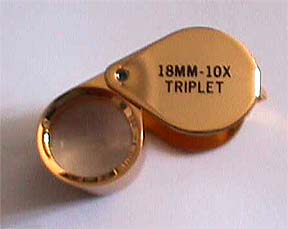|
 Jeweler's Loupe Jeweler's Loupe
Perhaps the most important tool in gemology is that of the
jewelers loupe...pronounced "LOOP". This most important
piece of equipment...in the right hands...can serve as the foremost
identification and grading tool.
There are two important factors about making the decision
regarding which loupe is right for you. The first is the size
of the lens. Most good quality loupes will have an 18mm lens
in 10x or 10 power. This is the standard for most gemologists...however,
larger and smaller size lenses are available. And loupes in the
20x or 30x are available....but not worth much because the lenses
have to be so small at the higher magnification that they are
not much use. So a 18mm 10x loupe is the first consideration.
Second, is the optical quality of the lenses. The cheap loupes
you find on eBay or elsewhere that sell for a few dollars are
worth what you are paying. Mainly because the optics are cheap
and the lenses have not been corrected for aplanatic and achromatic
aberrations. WHATS THAT?...you may be asking. This is where
three lenses are used to make the better quality jeweler's loupe
that correct the lenses so that the field of vision is
in focus all the way to the edges, and so that the lenses do
not impart false color to what you are seeing.
An example of aplanatic correction is shown below.
In the first block you see one of the cheap $10.00 loupes. As
you can see, the edges get fuzzy and out of focus. Meaning that
when you use this loupe you cannot see all of the gemstone across
all of the field of vision. This is called aplanatic aberration
and is a bad thing for a loupe to have. And all of the cheap
ones have this problem. |

